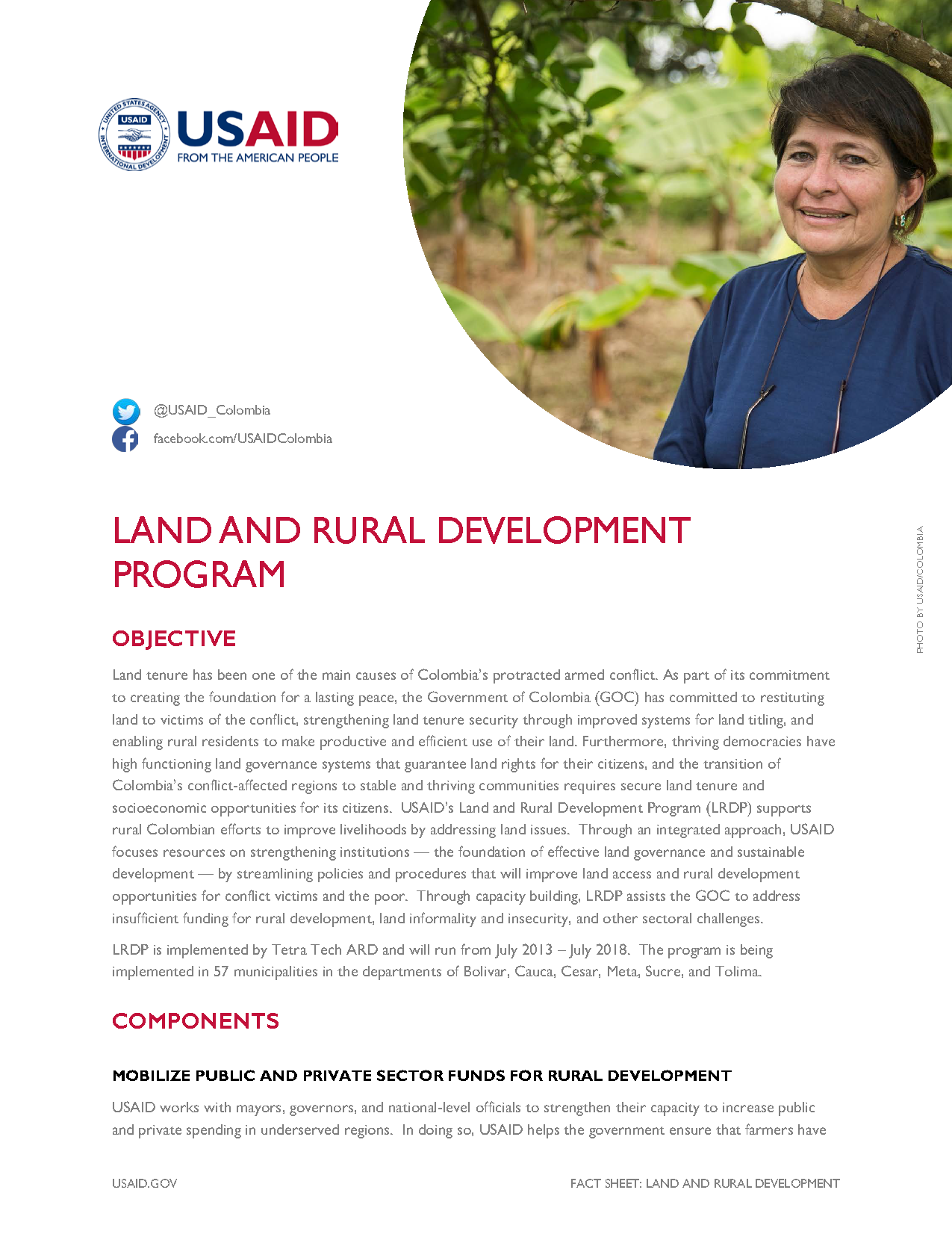Land and Rural Development Program ![]() (pdf - 182k)
(pdf - 182k)
OBJECTIVE
Land tenure has been one of the main causes of Colombia’s protracted armed conflict. As part of its commitment to creating the foundation for a lasting peace, the Government of Colombia (GOC) has committed to restituting land to victims of the conflict, strengthening land tenure security through improved systems for land titling, and enabling rural residents to make productive and efficient use of their land. Furthermore, thriving democracies have high functioning land governance systems that guarantee land rights for their citizens, and the transition of Colombia’s conflict-affected regions to stable and thriving communities requires secure land tenure and socioeconomic opportunities for its citizens. USAID’s Land and Rural Development Program (LRDP) supports rural Colombian efforts to improve livelihoods by addressing land issues. Through an integrated approach, USAID focuses resources on strengthening institutions — the foundation of effective land governance and sustainable development — by streamlining policies and procedures that will improve land access and rural development opportunities for conflict victims and the poor. Through capacity building, LRDP assists the GOC to address insufficient funding for rural development, land informality and insecurity, and other sectoral challenges.
LRDP is implemented by Tetra Tech ARD and will run from July 2013 – July 2018. The program is being implemented in 57 municipalities in the departments of Bolivar, Cauca, Cesar, Meta, Sucre, and Tolima.
COMPONENTS
Mobilize public and private sector funds for rural development
USAID works with mayors, governors, and national-level officials to strengthen their capacity to increase public and private spending in underserved regions. In doing so, USAID helps the government ensure that farmers have access to the resources they need—such as irrigation and technical assistance—to increase agricultural production and reduce poverty. Special attention is placed on the incorporation of land beneficiaries into income-generating initiatives. By 2018, USAID will establish 13 public-private partnerships to mobilize public and private sector funds and incorporate beneficiaries of land restitution and formalization into licit, income-generating business activities.
Formalize land rights and provision of tenure security
Approximately half of rural properties in Colombia are informal. Land informality inhibits citizens and public entities from accessing investments. In addition, citizens without land rights oftentimes lack the incentives necessary to sustainably manage natural resources, increasing the potential for environmental degradation and the improper use of land. By 2018, USAID will help the GOC pilot a massive land-titling approach to reduce the average time and cost of securing land rights.
Restitute land to victims of conflict
The Land Restitution Unit and other GOC agencies involved in restitution have encountered significant challenges to restitute land to claimants. For example, there are currently 2,000 rural families occupying land that is being claimed by others. Many of these families are entwined in complex legal cases, but cannot afford a lawyer. USAID helps the Land Restitution Unit address these challenges, and also works to incorporate restituted families into strategic value chains with the help of public-private partnerships. By 2018, USAID will help the GOC accelerate the processing of restitution cases, in turn helping restituted families to secure new socioeconomic opportunities. USAID will also support the Public Defender’s Office in providing legal representation to 800+ vulnerable families occupying land being claimed by others.
Improve the quality and accessibility of information to expedite land policies
Without access to high-quality, electronic land information, the implementation of land policies is slow, difficult, and costly. USAID is building the Land Node, an innovative information technology platform that aggregates data from eight land agencies and makes it available, in real time, to increase transaction efficiencies, reduce costs, and catalyze a positive economic impact across the country. By 2018, USAID will improve access to land data by digitizing over four million land files from six departments in order to fill the information gaps that currently impede restitution and formalization efforts.
RESULTS
- Mobilized approximately 44 dollars for every dollar invested by LRDP into conflict-affected regions from the public and private sectors.
- Mobilized $20 million for coffee, cacao, milk, and honey sectors through five public-private partnerships.
- Identified 750 schools in target regions that will undergo a six-month titling process to unlock social investment from departmental and municipal governments.
- Designed a massive titling methodology to reduce time and cost to formalize land while significantly expanding coverage. The methodology will be tested in 2016-2017 with the National Land Agency.
- Provided 230 families occupying land that is being claimed by others in the land restitution process with legal representation from the Public Defender’s Office.
- Mobilized $5 million in one department and four municipalities for restitution efforts, which helps ensure the effective execution of Colombia’s restitution policy within LRDP’s focus regions.








Comment
Make a general inquiry or suggest an improvement.